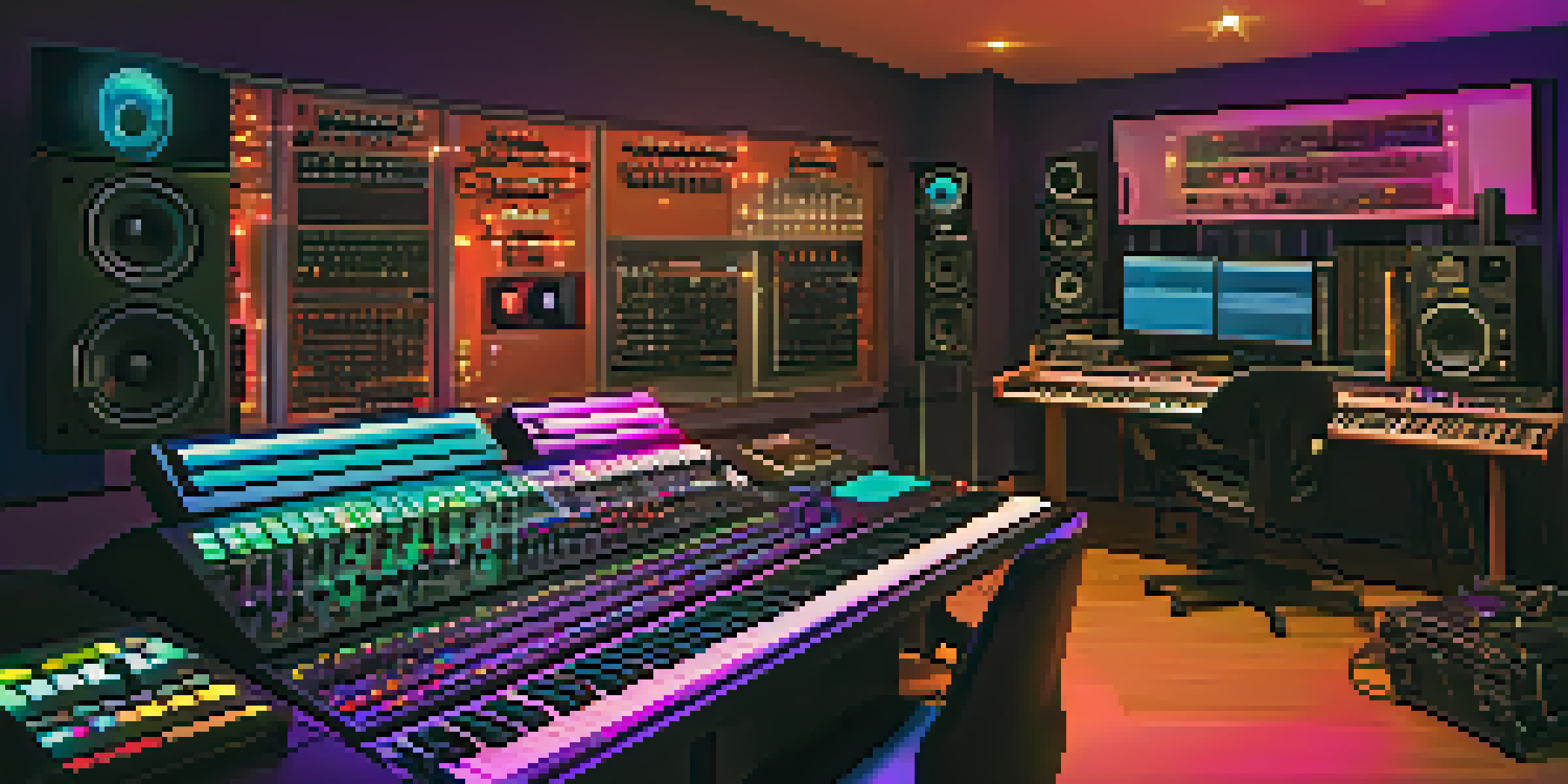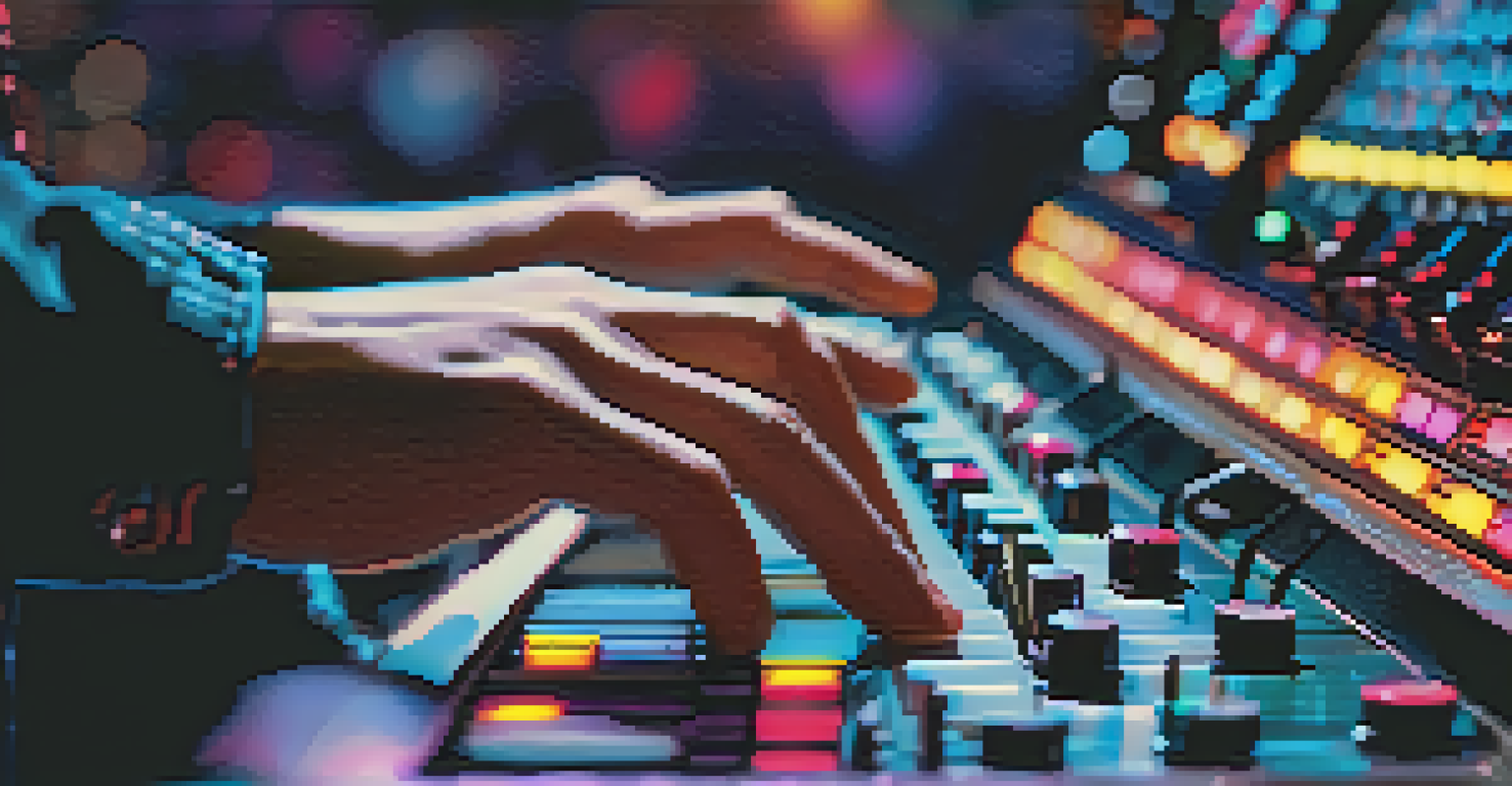Exploring Electronic Music Theory: New Sounds and Techniques

Understanding the Basics of Electronic Music Theory
Electronic music theory serves as the foundation for creating and understanding music in a digital environment. At its core, it encompasses the study of sound, rhythm, and harmony, but with a unique twist that embraces technology. Unlike traditional music theory, electronic music often blurs the lines between instruments and genres, leading to a rich tapestry of sounds.
Music is the shorthand of emotion.
Imagine a painter who mixes colors freely, creating an entirely new palette; that’s what electronic music allows composers to do with sound. By understanding the basics, musicians can explore new creative avenues, experimenting with synthesizers, drum machines, and software that reshape how music is composed. This flexibility is key for anyone eager to dive into the electronic scene.
Moreover, grasping the fundamentals enables artists to communicate their ideas more effectively, whether they are collaborating with others or producing tracks solo. So, whether you're a seasoned musician or just starting, a solid grounding in electronic music theory can open up a world of sonic possibilities.
The Role of Synthesizers in Sound Creation
Synthesizers are the heart and soul of electronic music, offering an endless array of sounds that inspire creativity. These devices can mimic traditional instruments or create entirely new ones, giving artists a vast range of sonic textures to explore. From simple waveforms to complex soundscapes, synthesizers allow musicians to sculpt their audio landscape.

Think of a synthesizer as a sculptor's tool; just as a sculptor shapes clay into a masterpiece, musicians can manipulate sound waves to create unique auditory experiences. With various types of synthesis—like subtractive, additive, and FM—each approach offers different ways to generate sound, making experimentation both exciting and essential.
Foundations of Electronic Music Theory
Understanding electronic music theory empowers artists to explore sound, rhythm, and harmony in innovative ways.
As artists become more familiar with their synthesizers, they can develop their signature sound, setting them apart in a crowded music landscape. Understanding these tools not only enhances creativity but also empowers musicians to push the boundaries of what electronic music can be.
Harnessing Rhythm: Beats and Patterns in Electronic Music
Rhythm is the backbone of any musical composition, and in electronic music, it takes on thrilling new dimensions. Electronic artists often use drum machines and sequencers to craft intricate patterns that pulse with energy. This allows for a level of precision and complexity that can create compelling grooves, enticing listeners to move.
The only way to make sense out of change is to plunge into it, move with it, and join the dance.
Picture a heartbeat; just as it keeps us alive, rhythm breathes life into music. In electronic tracks, beats can be layered and manipulated to create a dynamic listening experience. Whether it’s a steady four-on-the-floor beat or complex polyrhythms, the exploration of rhythm can lead to innovative compositions that resonate with audiences.
Moreover, the flexibility of digital audio workstations (DAWs) means that artists can easily experiment with different tempos and time signatures. This encourages a playful approach to rhythm, allowing even novice musicians to craft engaging beats that captivate listeners.
Exploring Sound Design Techniques for Unique Audio
Sound design is a crucial aspect of electronic music that enables artists to create distinctive audio signatures. This process involves manipulating sound waves through various techniques, such as sampling, granular synthesis, and effects processing. By understanding sound design, musicians can turn ordinary sounds into extraordinary sonic experiences.
Consider how a chef uses spices to create unique flavors; sound designers do the same with audio, blending elements to create rich textures. For instance, layering different sounds can produce a fuller, more immersive experience. Whether it’s adding reverb to give depth or using filters to create movement, the right techniques can elevate a track remarkably.
The Power of Synthesizers
Synthesizers are essential tools in electronic music, allowing musicians to create a diverse range of sounds and textures.
Ultimately, the journey of sound design empowers artists to express their individuality and creativity. By experimenting with different techniques, musicians can discover their unique sound palette, setting their work apart in the vibrant electronic music scene.
The Impact of MIDI on Electronic Music Production
MIDI, or Musical Instrument Digital Interface, revolutionized the way music is produced and performed. This technology allows for seamless communication between instruments and computers, enabling musicians to control various aspects of their sound. MIDI has made it easier than ever to compose, edit, and produce music with precision.
Imagine MIDI as the conductor of an orchestra, coordinating different instruments to create a harmonious piece. It allows artists to record performances, edit notes, and manipulate sounds in ways that were previously unimaginable. As a result, musicians can experiment without the constraints of traditional recording methods.
Furthermore, MIDI's versatility means it can be used in various genres, making it a valuable tool for any electronic musician. By embracing MIDI, artists can unlock new creative possibilities and streamline their production processes, ultimately enhancing their music.
Embracing Experimentation in Electronic Music
One of the most exciting aspects of electronic music is the encouragement of experimentation. Unlike classical genres, electronic music thrives on innovation, allowing artists to push the boundaries of sound. This spirit of exploration often leads to unexpected and groundbreaking results that can redefine musical landscapes.
Think of experimentation as a playground; it invites musicians to test their limits and discover new ideas. Whether it’s combining genres, altering sounds, or using unconventional instruments, embracing experimentation can spark creativity and lead to fresh perspectives in music-making. It’s all about taking risks and enjoying the process.
Embracing Experimentation in Music
The spirit of experimentation in electronic music encourages artists to push creative boundaries and discover new sonic landscapes.
Moreover, the availability of digital tools makes it easier than ever to experiment without the fear of failure. Musicians can quickly test ideas, make adjustments, and learn from their experiences, fostering an environment where creativity can flourish. In this way, the electronic music genre continues to evolve and inspire.
The Future of Electronic Music Theory and Its Evolution
As technology continues to advance, the future of electronic music theory is filled with exciting possibilities. The emergence of artificial intelligence (AI) and machine learning is already changing how music is composed, offering new tools for creativity and collaboration. This evolution opens doors for artists to explore uncharted territories in sound and composition.
Imagine a world where AI can analyze music trends and help musicians craft hits with precision; this is becoming a reality. As more artists embrace these technologies, we may see a significant shift in how music is created and consumed. This fusion of technology and artistry could lead to new genres and sounds that redefine the landscape of electronic music.

In conclusion, the future of electronic music theory holds endless potential for innovation and creativity. By staying open-minded and adaptable, musicians can harness these advancements to create music that resonates with audiences worldwide, ensuring the genre's evolution continues.